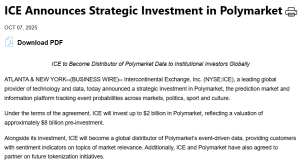Czech National Bank Launches $1 Million Digital Asset Pilot Including Bitcoin and Stablecoin
- Bitcoin gains stronger institutional legitimacy as the CNB’s $1 million pilot becomes the first case in a central bank directly holding BTC.
- Despite Bitcoin’s slip below $100K, extreme fear signals and rising institutional interest suggesting form for a medium-term recovery.
Bitcoin takes center stage as the Czech National Bank (CNB) unveils its first-ever digital asset portfolio, allocating $1 million into Bitcoin (BTC), a U.S. dollar-pegged stablecoin, and a tokenized bank deposit. This aligns with a recent Crypto News Flash (CNF) report on the earlier discussion of when the Czech National Bank considered a billion-euro Bitcoin investment after a reserve discrepancy was identified.
This newly announced pilot, revealed on November 13, marks the first time a central bank has directly acquired cryptocurrencies for operational testing—signaling a cautious but meaningful step toward integrating blockchain technology into traditional monetary systems.
Furthermore, Coin Bureau added that alongside BTC, the portfolio also includes a USD stablecoin and a tokenized deposit.
According to reports, complementing the pilot, the CNB also launched its “CNB Lab,” an innovation hub focused on exploring blockchain, AI, and instant-payment technology.
Hence, this internal think-tank will simulate real-world applications, including tokenized Czech koruna bonds payable via a single mobile tap—envisioning a seamless user experience from everyday coffee purchases to investment transactions.
Additionally, the bank plans also to publishing quarterly transparency reports on its digital-asset holdings and performance, followed by a comprehensive two-to-three-year review to assess long-term scalability.
This initiative shows that central banks are not longer merely as observing crypto developments—they are now willing to hold, test, and build operational experience with digital assets. Such actions may encourage other central banks, especially across Europe, to follow suit.
Market Implications for Bitcoin (BTC) Price
According to today’s CNF report, Bitcoin’s recent pullback below $100,000 has triggered short-term concern, yet the broader of outlook remains constructive. Santiment’s indicators show extreme fear at social-volume peaks between November 6 and 14—levels that is historically signal capitulation, when weaker hands sell and long-term holders or institutions accumulate. This suggests the stage may be set for a recovery.
At the same time, the Czech National Bank’s launch of a $1 million digital-asset pilot that includes Bitcoin, a USD stablecoin, and a tokenized the deposit which reinforces Bitcoin’s legitimacy. By becoming the first central bank to hold Bitcoin in such a structured way, the CNB strengthens the narrative of BTC as a reserve-asset candidate—even if the amount is small relative to its market cap.
Historical moves like El Salvador’s 2021 Bitcoin adoption triggered short-term rallies of 10–20%. Here, similar momentum could be amplified by European institutional validation and shifting policy environments.
Subsequently, bearish risks appear at limited level. The CNB’s pilot is clearly framed as experimental rather than a full reserve shift. Although concerns about volatility remain—even acknowledged by the bank—Bitcoin’s appeal as an uncorrelated store of value continues to attract cautious institutional interest.
As of now, Bitcoin (BTC) is trading at the price of $96,823.17 with a decrease of 6% in the past day and 4% in the past week. If this pilot successfully demonstrates secure custody, accounting, and compliance frameworks, it could open the door to billions in future sovereign or institutional allocations, sustaining long-term upward pressure. See BTC price chart below.
]]>You May Also Like

Bitcoin Breaks Below $100K But Stablecoin Inflows Hint at Quiet Re-Risking

Polymarket To Provide UFC, Zuffa Boxing With Real-Time Fan Predictions
